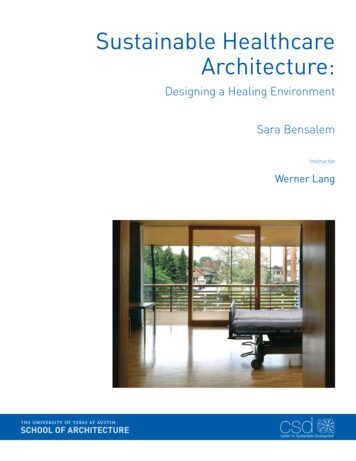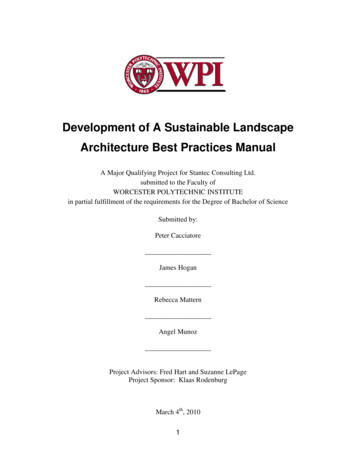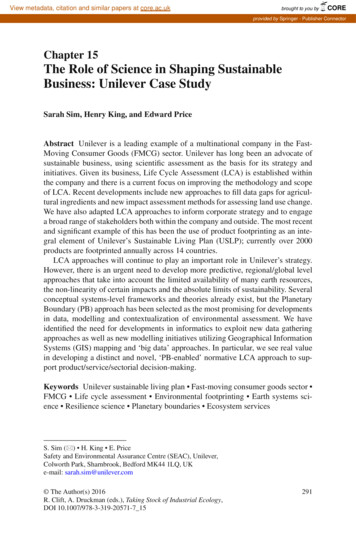
Transcription
Sustainable HealthcareArchitecture:Designing a Healing EnvironmentSara BensalemInstructorWerner LangcsdCenter for Sustainable Development
The University of Texas at Austin - School of Architecture - UTSoASustainable Healthcare ArchitechureDesigning a Healing EnvironmentSara Bensalemmain picture of presentationFig. 01 This ia a side by side comparison of typical hospital rooms in a susatainably designed hospital (left) and a modern hospital(right). From this view it is easy to see which hospital offers a better healing envrionment. The left has natural lighting, views of theoutdoors, direct access to the outdoors through the patio, wood interiors, spacious room, and one bed per room. The right is a sharedroom with artificial lighting, no windows, white walls, and grey floors. The simple question is which room fosters a better healingenvironment? The sustainably designed one or the modern hospital room.Sustainable Healthcare ArchitectureHealthcare facility design is a complexendeavor that forces function to followboth form and quality. Healthcare facilities serve a wide range of functionsfrom medical applications (i.e. diagnostic, treatment, emergency rooms,clinics, etc.) to functional programs(i.e. food services, housekeeping,waiting rooms, meeting areas, officespace, etc.). Designers of a healthcarefacility are required to look at everyaspect of human life. These facilitiesare spaces people live (temporally fortreatment) and work in, where theyare born and die. With modern medicine’s reliance on technology and demanding building programs, designersof modern hospitals may view healthcare architecture as incompatible withthe principles of sustainable design.However, sustainability is not only amoral obligation for the healthcarefield, it is beneficial to the patient andfosters a healing environment. Sus-tainable practices should be adoptedfor future constructions and renovations of healthcare facilities. Thesepractices will not only save moneyduring the lifespan of most healthcarefacilities, they will also make spacesmore effective for healing.Sustainable ArchitectureSustainable Architecture looks furtherthan the building ecology or energyefficiency, and towards the end user’sexperience, placing people at thecenter of the design process. Sustainability is not about sacrificing comfortor lifestyle for environmental benefit, but to find design solutions thatincrease quality of life today withoutsacrificing tomorrow. The sustainabledesign process focuses on the peoplewho will utilize the project, and forthis reason, sustainability applied tohealthcare architecture has the mostpotential to benefit building users.The medical field is only starting to
The University of Texas at Austin - School of Architecture - UTSoAnow accept sustainability into thebuilding practices. Medicine is nota place of risk, because at the coreof a healthcare facility the missionis medical treatment for the patient. Out of the box thinking is nota chance that medical professionalswant to take. In general, changesin medical environment happensslower then in other parts of theeconomy (Butler et al., 1996). Forthese reasons sustainability has notbeen widely adopted in healthcaredesigns.Health Challenges for the 21stCenturyMany of the upcoming problems inhealth that will have to be treated inthe healthcare facilities are problemsthat can be linked to the built environment that people have created.The way that we live and the placesand spaces that we live in have madea unique environment that does notpromote healthiness. The currentgeneration of the industrializedworld is projected to be the first notto live longer then the previous ones(Daniels, 2006).Health challenges that the youth willface in their life are asthma, developmental disabilities, diabetes, obesity,reduced fertility, cancer, and heartdisease. These health impacts havesignificant linkages to the technology advancements, and changes withindoor/outdoor environments. Inaddition, lifestyles have further isolated people from interactions withothers and added stresses to life withincreased productivity trends at theworkplace. The lifestyles currentlylived by Americans are unsustainable, and the hospitals that will treatthe problems associated with thisshould be models of a sustainableSustainable Healthcare Architectureand healthy lifestyle.Mind-Body ConnectionEven though changes happen slowlyin the medical field, the new subdiscipline of integrative medicine isshowing promise of changing theway medical doctors look at theirpatients. Integrative medicine is aholistic movement in the medicalfield, which looks at treatment of thewhole person not just the illness orsickness. The mind, body, and soulis treated to increase probabilitiesof success. This movement is basedon the idea that pain and sufferingis not felt in a particular part of thebody, but is interpreted in the mind.A healthy mind and psychology offersthe body greater support in the healing process.There is evidence that psychologicalstress adversely affects the immune system (Kiecolt-Glaser et al.,1995). In a study preformed on theeffects of wound healing, KiecoltGlaser et al. took a group of patientswith Alzheimer’s disease and acontrol group inflicting them with apunch biopsy (a low-risk techniqueused extensively in dermatological research), and then monitoredthe healing process of the wound.People inflicted with Alzheimer’sdisease are known to have stresslevels substantially higher then normal. The results of the study wereprofound showing a linkage betweenthe stress levels of a patient andhealing time (are shown in Figure 2).About half of the control group withnormal stress levels healed within5 weeks, while it took over 6 weeksto see healing comparable from thepatients with Alzheimer’s disease.Stress levels inhibit recovery, butFig. 02 Results from the Kiecolt-Glaser et al. study on rateof healing in patients with Alzheimer’s disease and a controlgroup. The patients with Alzheimer’s took considerablelonger to heal. The study attributed this to stress.positive thinking and determination has helped patients beat suchdiseases as cancer. The Livestrongfoundation is an example of usinghealthy mindsets to promote healingduring the very invasive treatmentsof chemotherapy. Many patientsundergoing cancer treatmentscredit the programs outlined by theLivestrong foundation for successfuloutcomes.This mind-body connection haslead doctors to have group therapysessions where patients talk aboutstruggles of their disease to support each other. Doctors practicingin integrative medicine have alsoincorporated hypnosis and meditation into normal pain relief therapy.These practices are currently beingresearched, and preliminary findingsare showing promising results ofincreased success rates and quickerrecovery times (Kligler & Lee, 2004).This type of medicine does not onlymake hospitals more productive butalso makes them more profitable.2
The University of Texas at Austin - School of Architecture - UTSoAAchieving high performance hospitals with principles of sustainabledesign is following a similar routeof adoption as integrative medicine.Today new building constructionsand renovations are demonstrating that green building principlesare not only ecologically and environmentally responsible, but in theend create spaces that are of higherquality and achieve more productive.As more hospital demonstrate thatsustainable architechture benefitsthe healing of the patients, a generalacceptance of new hospital designwill follow. This paper will explorethe building-mind-body connectionthat can be fostered through sustainable development of healthcare toproduce healing environments.Healthcare and SustainabilityHealthcare is the preservation ofmental and physical health by preventing or treating illness. A healthyperson is not one with just theabsence of disease, but health is astate of physical, mental, and socialwell-being. In general, healthcare isnot practiced with this idea, modernhealthcare systems treat peoplelike machinery. Modern healthcarefacilities fix parts as if the person isa collection of mechanical systems.People though are more complexthan machinery. The mind is not onlythe central control of conscience butalso the place where all pain is felt,all healing is commanded, and wherepeople perceive their environment.If the mind has the power to heal,fostering an environment thatpromotes mental wellness shouldtranslate to the physical healing ofthe body. Architecture has shownthat the environment that peoplecreate has profound impacts on thehuman psyche. Sustainable designsof workplaces have shown thatproductivity levels increase (Heschong, 1990). Sustainable designsof schools have shown that studentperformance increases (Heschong,1990). Healthcare facilities haveonly recently adopted sustainablepractices, however some components of sustainable design can befound in healthcare facilities of thepast. These include natural ventilation and day lighting. The cases thatare outlined in this paper show thatsustainability has the power to createa healing environment.Indoor Environment QualityToday Anericans spend betwen70-90 percent of their days indoor(Brown, 1994). The human body isnot adapted to life in these artificialenvironments (i.e. artificial lighting,cooling, and ventilation) cut off fromthe external environment. Whileshelter is a natural and instinctiveaspect of people, artificial environments of the past 40 years have ledto the sick building syndrome.In the same ways that architecturehas moved from very different building in different regions of the worldtowards a uniform internationaldesign style, the indoor environmenthas also changed towards an average comfort style. Humidity levelsare controlled, temperature is ata constant 21 degree Celsius, andlighting environments are artificiallylite. This has been the definition ofcomfort in our modern world, however inflexibility is not comfort. Truecomfort is a flexible environment thatgives people the ability to control it.Sick Building SyndromeSustainable Healthcare ArchitectureSick building syndrome is wellresearched by the medical field andarchitects (Brede-Weisflog, 1996;Burge, 2004; Burge, et al., 1987;Finnegan et al., 1984; Lyles et al.,1991; Redlich et al., 1997; Singh,1999; Stolwijk, 1991). Effects of sickbuilding syndrome are seen throughuncomfortable feeling of sicknessthrough headaches, dizziness,wheezing, eye irritation, respiratoryinfections, and fatigue. Most of theeffects of sick building syndrome areattributed to air quality problems. Itis estimated that about 20 percent ofthe American workforce is impactedby sick building syndrome (Levin,1989). The Environmental ProtectionAgency lists the key factors of sickbuilding syndrome as: Inadequate ventilation Pollutants emitted insidebuildings Contaminations from outsidesources Biological Contamination (i.e.mold growth due to excess humidity) Inadequate temperatures Excess humidity Poor LightingThe impacts of sick-building syndrome are documented as reducingproductivity, performance, and wellbeing of building occupants. Currently many hospitals in the industrialized world can be characterizedas prone to sick building syndrome.These impacts are extreme in hospitals where the spread of diseases arepossible. In Germany, about 1,500people die annually from diseasesthey contract in the hospital (Stolze,2005). The underlying motivationsfor healthcare facilities to pursuesustainable building designs aremoral, but they should also be seen3
The University of Texas at Austin - School of Architecture - UTSoAFig. 03 Circadian Rhythm is also known as the biological clock, which is a 24 hour cycle that is controled by the light-dark cyclesexposed to the human body.as financial and as part of healthtreatments (Houghton et al, 2010). Ahospital should not be a place thatpeople go and get sick in.In general, green buildings havemeasurably better IEQ than traditional buildings, with associated positive impacts on health (Kats, 2010).Figure 4 shows a survey of studieson green buildings’ positive impactson health due to the air quality. Thehealth benefits of green building design have shown linkage with patientrecoveries, in part because of thebetter air quality (Kats, 2010).Day lightingDay lighting also plays an importantrole in the healing process throughthe regulation of the circadiansystem. The circadian system is theregulation of body function basedon the day-night cycle. The body isadapted to daylight and uses it as aninternal clock, regulating all aspectsof physiology. The human body’sdigestive system, sleeping patterns,hormone regulations and evenbody temperatures show measurable differences throughout the day(See Figure 3). Through this systemday lighting aids in healing throughreducing depression, shorteninghospital Stays, and improving sleep(Joesph, 2006). Patients in day literooms have less pain, less stress,and are calmer. This translates to abody in harmony with nature, whichaids the healing process. In addition, worker performance and jobsatisfaction is increased, creating awork environment where doctors andnurses are more effective. With thepower of day lighting in the regulation of bodies, it is immoral to createhospital spaces like patient roomsthat do not incorporate daylight.Comparing French and British Hospital SystemsA study comparing French and British hospital systems preformed bythe Building Design Partnership,(a firm of architects, engineers,and designers), showed substantialdifferences in effectiveness of thehealthcare systems (BDP, 2004).They drew conclusions that each bedin a French hospital outperforms theBritish hospitals, which drives downcosts. The key findings of the reportwere:Sustainable Healthcare Architecture1. French hospitals deliver morebenefit for less cost than UKhospitals.2. The French use single bedwards to assist faster recovery.3. Day lite plans and good amenities aid staff wellbeing4. Good architecture in Francefosters community pride anduser morale.5. French hospitals cost betweenhalf and two thirds of the cost ofUK hospitals per m².6. Building servicing costs inFrance are less than half thoseof the UK with little artificialventilation used.BDP’s report attributed the difference to the building designs of thehealthcare facilities. The FrenchHealthcare Architecture regulationsadopt many of the characteristicscommon to sustainable design practices. The regulations require thathospitals are to be designed withdaylight in all occupied areas. Theyalso mandate single room floor plansthat accommodate overnight stays byfamilies. Also impose requirementsin which building:operation:staffcosts are set to 1:5:200. These limitsrequire a low cost construction andoperation, with daylight, naturalventilation, and social sustainability. Although they are not calledsustainable, the practices employedin France are close to the ideas ofsustainable design.The resulting buildings have largesurface area to volume ratios, insuring day-lighting to all part of thebuilding, providing views from thepatients’ rooms of the outside, andhaving better air quality with naturalventilation techniques. The benefitsof this approach resulted in better4
The University of Texas at Austin - School of Architecture - UTSoASustainable Healthcare ArchitectureFig. 04 A survey of literature on the health gains from improved indoor air quailtyhealth rate from hospitals in Francethan those in the UK and higher morale among the patients and doctors.Sustainable Versus Traditional Hospital WardsBuilding extension projects haveoffered a great opportunity forresearchers to study the impactsof new building design comparedto older sections of the buildings.Professor Bryon Lawson researchedthe impacts of a building extensionproject at Brighton Hospital. Thehospital served the same populationsof patients and the rooms were usedfor the same types of treatments inthe older and newer sections of thehospital. The Doctors and staff alsocame from the same pool. This casestudy offered a unique opportunity tostudy the differences in patient outcomes in new building design. Thenew building regulations in effectwere closer to sustainable conceptsin green design.The results showed a positive gainin patient care in the new sectionof the hospital. Figure 5 shows theresults of patient surveys on satisfaction of the medical treatmentand the doctors’ performance. Thepatients in the new units rated boththe treatment and the doctors higherwhen having treatment in the newersection of the hospital. In additionto the perception of the patient, theoutcomes were measured both inovernight stays and types of drugstaken. These results are shown inFigure 5. The overnight stays werelower showing that the patients feltwell enough after treatment to gohome. The types of medications alsodiffered, in that less powerful classC drugs were prescribed as opposedto the more powerful class A. Sinceclass A drugs are made up of powerful pain relievers this result can beinterpreted as the patients did notcomplain as much about pain, andless powerful drugs were strongenough.Reduction in hospitalization staysand less drugs is the equivalent ofmoney savings in the healthcareindustry. The average hospitalnight stay costs 1,200 in the UnitedStates. In addition, the Class A drugsare generally more expensive thenClass C drugs. Green hospital designcould even lead to stronger results,but future studies are needed.Fig. 05 Results of patient surveys on medicaltreatment quality in the newer rennovatedversus the older hospital wards in BrightonHospital, England. (Lawson, 2004)5
The University of Texas at Austin - School of Architecture - UTSoASustainable Healthcare Architectureers. Often in very public parts of thehospital patients in their gown walkthrough, lost, looking for their nextoffice.Fig. 06 Exterior view of Klinikum Großhadern from the grounds of the hospital. Klinikum Großhadern is the fourth largest hospital in Germany and the largest in Munich. The building features aluminim panels used to reduce heating and cooling loads. Thebuilding looks metalic and is known as the “toaster” by the attending medical students.Klinikum Großhadern, DEArchtect: Godehard Schwethelm andWalter SchlemppOperated by: Fachkliniken Nordfriesland GmbHLocated at: Marchioninistraße 1581377 München, DeutschlandDate: 1977Beds: 1,418Area:Total Cost: 367 Million EurosWebsite: www.klinikum.unimuenchen.deThe Klinikum Großhadern of theLudwig Maximilians University isthe largest hospital in Munich andthe fourth largest in Germany. Ithas 1,418 beds and offers the widestrange of services of all the hospitalsin the city. The building featuresan aluminum façade that acts as asecondary façade shading the actualfaçade of the building. The studentsattending LMU medical program refer to the building as ‘the toaster’ because of its rectangular long shapeand metal exterior. The hospital isknown for its innovative equipmentand is designed to accommodatetesting for numerous patients inthe region. The building has about500,000 patients per year with over1,800 doctors.The layout of the hospital is muchlike an airport. When entering thehospital there is a lack of informationand greeting services. Most information is delivered by signage markingoff different sections of the hospitalwith letter and color codes. Navigating the hospital takes place througha central corridor that encompassesthe length of the building. The hospital is generally cold and lacks viewsof the natural garden surrounding the campus. Many views fromwindows are of other windows in theadjacent buildings.The building is large and mostlyempty of people. It is not uncommonto look down a long corridor and findno one. Also there is a general lackof community in the hospital. Mosthospital staff walk looking down atthe ground, with little eye contact.There is a lack of congregation andtalking amongst the building us-The hospital is built like a machineand is made to process as manypeople as possible. There is amplespace left empty. The hospital systems works like a factory, with cartspulling wagons. Much of the feel inthe hospital is that of a factory formedical care. The hall also lacksnatural light and the artificial lightingis not strong enough, often leavingthe interior of the building dark. Thehumidity levels of the building arehigh and the temperature is cold.Windows have condensation formingon them.The surrounding gardensof the hospital are very pleasant andare often visited by patients for recuperations. This serves as an escapefrom the cold inside of the building.Overall, this building is made formaximum output, and does not create a welcoming healing space. Thebuilding interiors are not comfortableand most people visiting the hospitalremain outside in gardens and publicbenches. Future studies should lookat the success rates and comparethis hospital to its downtown branch,which occupies a historic building. Given that the two hospitalshave similar functions and the sameadministration, patient surveys ofquality of care could result in usefulstudies on the healing environment.6
The University of Texas at Austin - School of Architecture - UTSoASustainable Healthcare ArchitectureFig. 07 Building relies on the use of signage for patients and visitors to orientethemselves.Fig. 08 Interior courtyards are surronded by large building facades making themunconfrotable to be in.Fig. 09 Due to large hospital, trash is left in hallways infront of elevators. This is dueto the lack of “eyes on the street” in empty hallways.Fig. 10 Condensation on windows show that the indoor air quality is too cold andhumid compared to the outdoors.Fig. 11 Large empty spaces in the building.Fig.12 Interior courtyards lacking green spaces and very industrial looking.7
The University of Texas at Austin - School of Architecture - UTSoASustainable Healthcare ArchitectureFig. 13 Lengthy straight hallways which rely on signs for directions.Fig. 14 Poorly lite hallsFig. 15 The building plan is simillar to airports, with zones coloredand numbered.Fig. 16 Uncomfortable seatings randomly located in the hallwaysfor waiting.8
The University of Texas at Austin - School of Architecture - UTSoAFig. 17 Exterior view as approaching entrance to KlinikumNeuperlach. Features renovated glass panel facade, fountains, and outdoor cafe.Fig. 18 Entering the building, visotrs are greated by a naturally lite courtyard.Klinikum NeuperlachArchtect: Beed – Geiselbrecht – Lernke Architecken GmbHOperated By: Stadtische KlinikenMunich GmbHLocated at: Oskar-Maria-Graf-Ring51, 81737, München, DeutschlandReinnovation: 2005Beds: 594Area: 8,074 square metersCost: 20.5 Million EurosWebsite: ch/larger floor space, in which theonly solution was to add additionalfloors to the top of the flat structure.Through the renovations, the newdesign corrected many mistakes thatthe older design had. For example,the numbers of beds were reducedfrom 765 to 594, making more spacious rooms for patients.The Klinikum Neuperlach, constructed in the 1970s, representsthe typical clinic design of the era.The building was very commercialand was designed for efficiency.The original building contained 765beds and the design was not madeflexible for future medical advancements. After 30 years of use, thebuilding out lived its usefulness andrequired complete renovations toprovide modern medical procedures.The redesign of the hospital requiredThe most important element of thenew design, was constructing anair space through the center of thebuilding. This space adds air volumeto the building, greatly improvingindoor air quality. The top of theair space features a glass roof thatallows for direct sunlight to enterthe building, warming it and givinga pleasant lighting effect throughout the corridors surrounding thiscentral courtyard on every level ofthe building. The courtyard servesmultiple purposes; air ventilation,natural lighting, and a central areafor patients to orient themselveswhen navigating the building.Sustainable Healthcare ArchitectureFig. 19 View from above shows the glass roof that allowslight to enter the building.Patient waiting rooms on everylevel are located next to the centralcourtyard, lined with potted plantsand comfortable furniture. Familieswait in these areas also. In addition,a covered area was created in frontof the entrance of the building, whichserves as the entrance, pavilion, andsidewalk café. When entering thebuilding the lower floor is well lite,and the air smells fresh. Geothermal cooling is used to bring fresh airinto the building. Finally, the façadeof the building was ornamented withmulti-colored glass giving it a modern look.This building is an example of how tocorrect the mistakes of the old building design, where the hospital wasa functional machine. The designerbrought sustainability into the hospital, which greatly improved the lookand feel of the place.9
The University of Texas at Austin - School of Architecture - UTSoAFig. 20 The building is integrated into the urban neighborhoodRotkreuz-KrankenhausMunich, GermanyArchitect: RRPArchiteckten IngenieureOperated by: Bayerisches RotesKreuzLocated: Rotkreuzplatz 8 80634München, DeutschlandReinnovation: 2009Beds: 324Area: 6,544 square metersTotal Cost: 81.7 Million EurosWebsite: www.rotkreuzklinikenbayern.deThe Rotkreuz-Krankenhaus locatedin the inner city of Munich is ownedand operated by the Red Cross ofBavaria. The buildings have a richhistory spanning over 135 years.This history as well as the Red Crossculture of caring for the well being ofthe patients makes this hospital theleading one in comfort and care inMunich.The building has been in a constantstate of renovation since the late1980’s with plans to continue tomodernize the grounds to supportinnovative treatments. The building’s history is complex with manySustainable Healthcare ArchitectureFig. 21 The interior is naturally liteconstruction periods; 70 percent ofthe building was destroyed in WorldWar II. Reconstruction of the building took until the mid-1960s. Laterin the 1980’s the high-rise tower wasadded to the building to add a modern look, serve as a landmark, andclose off the inner courtyard fromthe street. The modern renovationsbrought in natural lighting, naturalventilation, and additional wings forspecialized treatments.The renovations were planned in1979, but the realizations of theseplans are still not fully met. Theoriginal plan was to have the buildingrenovated over 10 years in 3 phases.The renovations have taken now over20 years with 5 out of the 6 phasescompleted. The plans were lengthened because of the complex situation of constructing in a fully operating hospital in the inner city. This isan example of the need for a flexibleand long-term thinking design plansto make renovations easier.physical experience. The gardensare visible from a majority of thepatients’ rooms. The access tothe garden areas is private for thepatients of the hospitals. The gardens do not only heal the patients,but also heal the building from thenegative effects of the inner city. Thethick trees provide sound protectionand a buffer from the noisy streets.These gardens serve as an island ofcalmness in the heart of the building grounds. The main hall of thebuilding is lite by two 4 x 4 metermirrors installed over the skylightto redirect the sun light, bringing inwarm natural lighting to the mainhall. The building has undergroundparking in order to preserve both thearchitectural look of the structuresand the green space created betweenthe buildings.The main design concepts surroundthe idea of the garden hospital,where green and natural spaces areprovided for both visual effect and10
The University of Texas at Austin - School of Architecture - UTSoAFig. 22 Historic portitions of the hosptal are preserved with art work andindirect natural lightingFig. 24 The interior courtyard has art scultures, and balconies that allow lightto enter the corridors of the hospitalSustainable Healthcare ArchitectureFig. 23 Emergency rooms have a sky light in their main corridorFig. 25 The front of the building has a modern entrance, without this entranceone would not know they were entering a hospital11
The University of Texas at Austin - School of Architecture - UTSoASustainable Healthcare ArchitectureThe additional costs will be quicklyrecuperated with the lower operationcosts of the hospital. The hospitalhas lower water usage and lowerheating/cooling costs. It also uses50% less electricity then comparablehospitals of its size, and generatesmost electricity on site throughcoupled heat and power plant.Dell Children’s HospitalAustin, Texas, USAArchitect: KarlsbergerOperated by: Seaton HospitalsLocated: 4900 Mueller Boulevard,Austin, TX 78723Construction: 2007Beds: 168Area: 42,000 square metersTotal Cost: 200 Million DollarsWebsite: www.dellchildrens.netThe Dell Children’s Hospital is thefirst Hospital in world to achievePlatinum LEED. This hospital embraced the concepts of sustainabilityto create a healing environment.Costs to Incorporate Sustainability tothe Hospital: 5% additional construction cost(of total) 6% additional design cost (oftotal) 11% total additional costs Total Costs: 200 Million Dollars 22 Million Dollars additionalcostsThe operation of the facilities alsoallow for costs savings. The administration has an easier take to recruitmedical staff, which also has highretention rates. The hospital is ableto retain the top talent of the country, because the building providesa space that creates a corporateculture of doing good. Preliminarystudies are showing that there arefaster patient recovery times (still instudy), however more studies mustbe done to determine the exact costsavings. Seaton claims that thehospital has gave them an overallcompetitiveness and advantage inthe marketplace. The sustainability features act as marketing toolsthat encourage people to choosetheir
In general, green buildings have measurably better IEQ than tradi-tional buildings, with associated pos-itive impacts on health (Kats, 2010). Figure 4 shows a survey of studies on green buildings’ positive impacts on health due to the air quality. The health benefits of green










